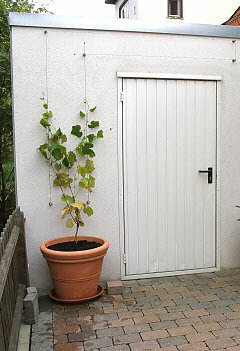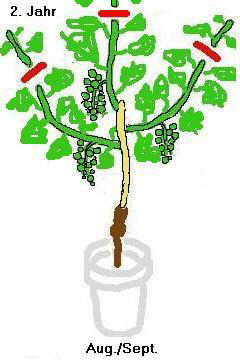Potted Grapevines
While they thrive better when planted in the earth, grapevines can also be grown in pots. Here are three possibile training techniques for container cultivation, depending on your purpose and container size. Please make use of the additional information provided under potted plants.

Miniature Grapevine
The smallest grapevine variety for perennial pot cultivation, for pots holding less than 10 litres.
Compact Grapevine
A compact, small, perennial variety, which can be trained in various cordon systems; for pots holding 20 liters or more.
Ornamental Grapevine
The empahsis here is on aesthetic. It brings lush grapes in the 2nd year, but will be much less productive in later years. Needs heavy ferlitilising after flowering. For containers > 10 litres. Usually only an annual.
Winter Protection
Wintering your vine is possible in a cellar or similar storage room (or an unheated shed), as long as the pot is kept moist and the temperature remains well below the critical 12ºC limit. Otherwise, budburst will occur prematurely and the plant may die. In modern cellars, the temperature is usually not cool enough, unless the cellar is unheated and permanently ventilated.
If the vine is wintered in a greenhouse or similar, it should be moved outside around early (around the end of February); premature budding under glass and subsequent exposure to the elements should be avoided at all costs. Plants which have already budded should only be transferred outside in April/May to protect the fragile young shoots from frost.

Training of a compact grapevine on a garage with wire rope system 2040

Diagram 01: Year 1~ The same as for all 1st year vines. A detailed description for training during the first year can be found under 1st year training. For the second year, during winter, the vine is cut back to a spur.

Diagram 02: Year 2 ~ Two shoots arise from the two buds of the spur, which ideally produce 1 - 2 grape bunches. For summer pruning, both shoots are trimmed back to about the 6th leaf (6 leaves above/beyond the last grape). Leave a single cluster on the bottom shoot.

Diagram 03: Year 2 ~ The upper part of the stem is now treated as a cordon and is spur pruned now and in the following years.

Diagram 04: Year 1 ~ The same as for all 1st year vines. A detailed description for training during the first year can be found under 1st year training. For the second year, the vine is cut back to "3 upper eyes" (dormant buds) in winter. A number of eyes on the stem are removed, depending on the desired growth form and height of stem.

Diagram 05: In the second year, 3 shoots arise from the 3 buds, which ideally produce 1 - 2 grape bunches each. For summer pruning, the shoots are trimmed back to about 6 leaves beyond the last grape bunch. If vine growth is rather weak, keep max.1 grape cluster per shoot.

Diagram 06: Depending on the local situation, the vine is then trained either into a small vertical cordon ("Schnurbaum"), fan form or horizontal cordon usually by spur pruning. However, even if the container capacity is 50 litres, the vine should not have more than 5 - 6 branches, 10 - 12 new shoots, and 20 - 30 grape bunches per year.

Diagram 07: Year 1~ The same as for all 1st Year grapevines. For the second year, the vine is cane pruned to 6 - 10 buds, depending on container size.

Diagram 08: Year 2 ~ The fruiting cane is carefully bent into a circle ("circular cane") around a support structure (tied like a horizontal ring onto a trellis of, for example, bamboo sticks). In the 2nd year, shoots arise from the 6 - 8 buds, which ideally produce 1 - 2 grape clusters each. Infertile shoots (i.e., shoots without flower buds) are removed, and after flowering, the plant is heavily fertilised. For summer pruning, the shoots are trimmed back to about 4 - 6 leaves beyond the last grape bunch.

Diagram 09: Year 2 ~ After harvest, this grapevine will no longer produce fruit, and, in the past, would simply have been disposed of. But, trimmed back to its initial shape (diagram 07), it will serve as an ornamental grapevine again. Replant into a container with renewed soil and give it a year to recover!




